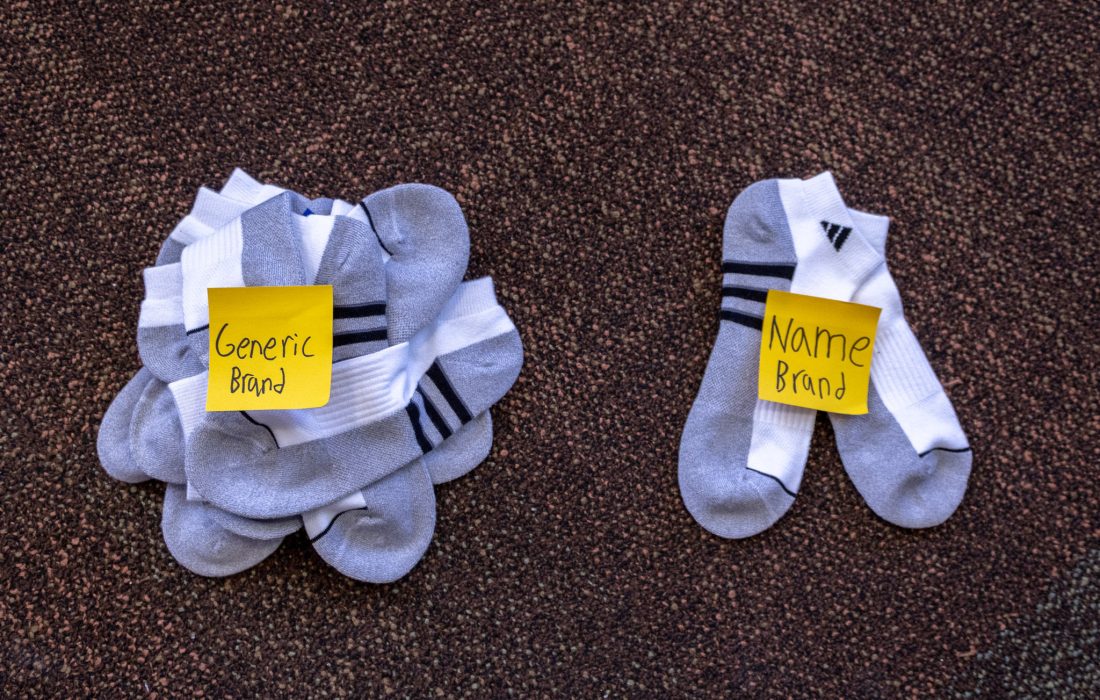Writer Julia Soeder talks about “Dupe Culture” and how it contributes to fast fashion.
Dupe Culture has Gone too Far
My roommate marked her return from the mailroom with a squeal of joy over — you guessed it — white socks.
But as she so kindly pointed out, they weren’t just any pair of white socks — these slightly smelly polyester pieces of cloth were a dupe for the $18 Aritzia socks.
And with that statement, capitalism won the war of quantity over quality.
Those who aren’t chronically online may have missed the revamp of the definition for the word dupe, which used to mean being deceived or tricked. Now, dupe is commonly used to describe something, typically an article of clothing, that’s a cheaper version of a pre-existing product — a duplicate.
Dupes aren’t the same as counterfeits because they don’t pretend to be the pre-existing products. Companies like ELF cosmetics market their products as a cost-effective alternative to high end makeup. Many businesses use this advertisement strategy for their brand as a dupe because attaching their merchandise to the more well-known company can help garner exposure. The marketing tactic made sense for companies trying to create cost-affordable versions of designer pieces.
But it has gone too far.
Instead of being an excuse to buy cheap, dupes have become a reason to spend more. Companies like Shein, a Chinese fast-fashion company, thrive off of online hauls by influencers showcasing their bottomless boxes of clothes for extremely adorable costs, according to Rolling Stone.
What used to be a term to describe the reinvention of designer products is being assigned to items like plain t-shirts, pants and shoes. The problem is these items aren’t dupes, they’re simply clothing. The black workout shirt bought on Amazon isn’t a Nike dupe, it’s a nylon shirt with everything but a swoosh attached to it.
The term “dupe” has turned into a catch-all phrase to describe any product without the eye-catching brand name to go along with it. Advertisers using the word dupe are like people who say “I love you” after the first time you meet them — the word loses all meaning when attached to every possible item on the planet.
My roommate fell victim to the white socks, but this is just the tip of the iceberg.
Advertisements for Skims dupes litter TikTok, showing women promoting tank tops on their Amazon storefronts, promising the $4 tops are the same quality as Kim Kardashian’s brand. These creators have an incentive to promote the dupe because Amazon’s influencer program allows for creators to receive a small percentage of sales when people purchase products from their links, according to Rolling Stone.
Social media’s ever-changing fashion trends have put into motion a trend cycle that feels like it’s over before it even starts. To keep up with the round-the-clock changes, fast fashion brands will stockpile possible trends, according to Rolling Stone. The term dupe is being weaponized to entice consumers into valuing quantity over quality.
Generation Z and millennials are the prime targets for advertisers trying to sell their dupes, according to CNBC, with almost 50% claiming they have intentionally purchased a dupe at some point.
Instead of buying one shirt for $25, brands like fast-fashion giant Shein try to sell consumers on their shirts that only cost a few dollars but seldom make it through the wash without ripping at the seams.
But, not everyone can afford to drop a paycheck every time they need new clothes. It’s important to have cost effective options so that everyone is able to participate in trends and feel confident in their clothes. No one should ever have to feel like their economic status is a barrier for being able to express themselves through clothing.
However, buying cost-effective products out of necessity is far different than those who overindulge on lower-cost alternatives. It is the greediness of those who can afford to do better but don’t that is ruining the way the clothing industry operates.
Dupe culture is the epitome of what it means to live in an overindulgent society. Clothing is no longer thought of as a farsighted purchase where spending a little more means getting a product that will last for years.
Now, the name of the game in the fashion industry is to try to convince people they need every possible color and design in order to keep up with the ever-changing trends.
This could affect practices such as donating or passing down clothes to other generations. If these pieces are only meant to last for a couple of wears and vintage pieces become few and far between, what will line the shelves of thrift stores or the boxes of clothes from parent to child?
It’s important that consumers understand less is more. Next time an influencer tries to broadcast a new dupe trend, keep scrolling.
Feature image by Ryan Pittman / The Phoenix

